Keio University’s Yearbooks From the Graduation Photo Taken in the Early 1880s to Current Yearbooks Today
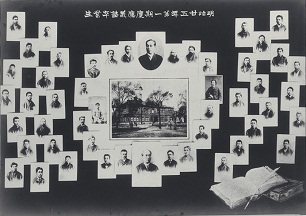
The photo in the center shows the school building, and above that is Yukichi Fukuzawa. The photo below the school building is then President Tokujiro Obata.*
Yearbooks surely sit on many Keio graduates’ bookshelves as prized possessions which hearken back to memories of younger days.
Tracing Keio’s yearbooks back through history, we found a group photograph taken in the Meiji period, which was taken in celebration of graduation. Today, unique yearbooks are created on each campus by student-led yearbook committees.
The original yearbook was a group photo taken in celebration of graduation
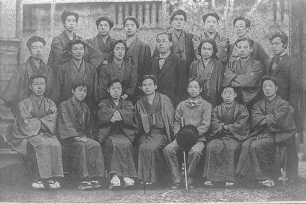
This is the oldest graduation photograph preserved by Keio University.*
In the early days of Keio University, there was no such concept as graduation. Even after relocating to Mita in 1871 after being established in Tsukiji Teppo-zu and then moved to Shiba Shinsenza, Keio still had no rules about graduation. Although students who had finished reading the prescribed books in the given order were considered to have completed the course, many chose to remain even after completion, continuing their studies while teaching junior students in the spirit of hangaku-hankyo, or “learning while teaching, teaching while learning.” Rules on graduation were only set, and school regulations revised, in 1873 in order to confer a certificate to prove completion of studies, and the next year the first “graduates” were born.
The oldest graduation photograph conserved by Keio University is of the honka (University) Class of 1883, a group photograph with Yukichi Fukuzawa in the middle. From 1892, a yearbook was created in the form a panel with centered photographs of Fukuzawa and then President Tokujiro Obata surrounded by individual photographs of graduates. In terms of creativity, the latter could be considered the earliest form of an actual yearbook.
The oldest yearbook that we know of in the form of a book, just like the current albums, is the yearbook for the graduating class of 1904. It is A5 sized and has 25 pages, and opens with a photograph of Yukichi Fukuzawa and the Rengakodo (Auditorium). Individual photographs appear two graduates per page.
In the later yearbooks, there are more photos of school activities and photos that describe the glory of each team of the Keio University Athletic Association. From the Taisho period, student editorial staff started to create albums by academic department (which later became faculties). The Keio University Yearbook Committee, which is formed by volunteers, is an ongoing autonomous activity run by students.
Yearbook production was suspended briefly after the Second World War due to supply shortages and other reasons, but activity resumed around 1950.
Five unique types of yearbooks created per campus
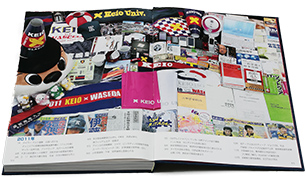
At the end of the album, there is a page about social events that occurred while at university. Visual contents are also created by the staff of the Keio University Yearbook Committee.
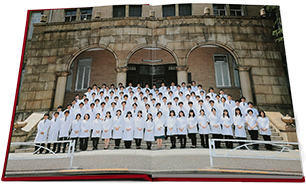
Due to the smaller size of the Faculty, all the graduates appear in a single photograph. In the beginning is a photograph of them in white coats, and at the end is another photograph in which students wear their team uniforms.
Today, five different types of graduation albums divided by campus are issued at Keio University.
The Mita Campus yearbook is a lengthy book that exceeds 500 pages and covers the Faculties of Letters, Economics, Law, and Business and Commerce. Until 2011, its photographs were all in black and white, which gave the yearbook a distinctively solemn feel, but it has since become colorized. One big feature is that it comes with a CD containing a message from the President.
The School of Medicine and Faculty of Pharmacy yearbooks have a lot in common and include snapshots that depict the friendly atmosphere and features based on questionnaires. Next to each individual photo is a comment from the graduate.
In the Faculty of Science and Technology, each laboratory is given free rein over page design, which leads to unique results. Each laboratory’s page is unique. Some are quite serious, explaining the content of their research, while others are full of the unbridled ideas of students.
At SFC, the yearbook is not for the graduating class alone; instead, a yearbook is issued every year, so students can get all four books as a memory of college life or purchase it only for a certain year. Students in any year can have their individual photograph taken, and their photo will appear in the book as long as they have their photo taken during the designated period.
It is only once you have become a graduate that you realize what precious and fond memories are stored in a yearbook. Recently, it has become popular to save photos digitally as data, but printed yearbooks have a special and distinct allure because they are a tangible medium: a book. If you happen to take that yearbook off the shelf in ten, twenty, or even fifty years’ time, you can instantly revisit memories of your college days, of the Sokei-sen and Mita Festival, and what’s more, you can meet a younger self—a Keio University student in the heyday of their youth.
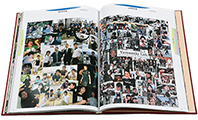
Each laboratory designs a page that represents the lab, and these idea-filled pages demonstrate the individuality of each lab.
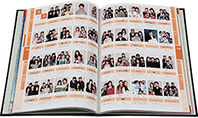
Individual photos of students from first- to fourth-year are shown sorted by year. Students can appear in the individual photo with their peers, rather than all by themselves.
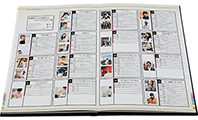
The album is full of interesting content such as rankings based on students’ evaluations of each other. There is also a page that shows a timeline of events that peers were involved in.
*Photographs used in the article are provoded by the Fukuzawa Memorial Center for Modern Japanese Studies.
